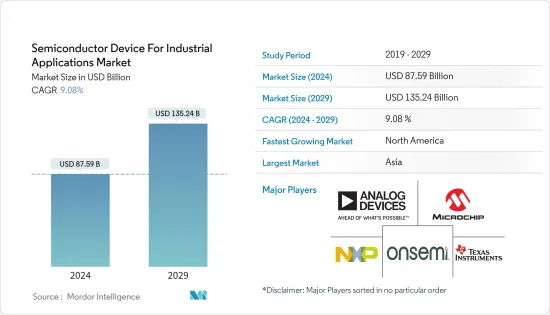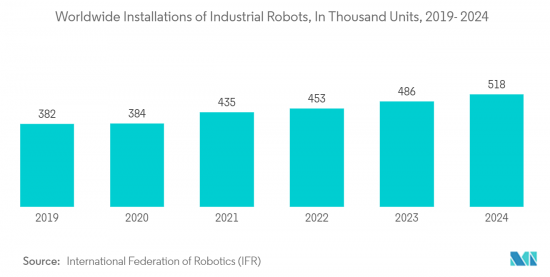PUBLISHER: Mordor Intelligence | PRODUCT CODE: 1408868

PUBLISHER: Mordor Intelligence | PRODUCT CODE: 1408868
Semiconductor Device For Industrial Applications - Market Share Analysis, Industry Trends & Statistics, Growth Forecasts 2024 - 2029

The Semiconductor Device For Industrial Applications Market size is estimated at USD 87.59 billion in 2024, and is expected to reach USD 135.24 billion by 2029, growing at a CAGR of 9.08% during the forecast period (2024-2029).
Key Highlights
- Semiconductor devices are increasingly adopted in industrial applications owing to the rapid growth in industrial automation. Industry 4.0 is transforming the way companies manufacture their products. Industry 4.0 refers to intelligent and connected production systems designed to sense, predict, or interact with the physical world, making real-time decisions that support production. It can increase productivity, energy efficiency, and sustainability in manufacturing.
- One of the most critical components of Industry 4.0 is the Industrial Internet of Things, which indicates the extension and use of the IoT in industrial sectors and applications. Semiconductors' underlying core capabilities for IIoT include sensing, connectivity, and computing. For instance, in IIoT, sensors are widely used in different industries to monitor equipment, assets, systems, and overall performance.
- Another critical enabler of Industry 4.0 and a common area of application of semiconductors is industrial robots, which are mechanical machines programmed to automatically perform production-related tasks in industrial environments.
- For their functioning, industrial robots require sophisticated sensors that obtain essential information. Sensors can use semiconductor processing units to gather external information like images, infrared light, sound, internal temperature, moisture, movement, and position data. Currently, many industrial robots are equipped with 3D vision systems, usually comprised of multiple cameras or one or more laser displacement sensors.
- The semiconductor industry's supply and demand were both significantly impacted by COVID-19. The shutdown of manufacturing sites and government-induced lockdowns severely affected the production and supply chain of the entire globe. The growing awareness of Industry 4.0 and the frequent adoption of intelligent factories accelerated market growth in the following years.
Semiconductor Device For Industrial Applications Market Trends
Sensor Segment to Hold a Significant Share in Industrial Applications
- Sensors are a vital part of factory automation and Industry 4.0. Motion, environmental, and vibration sensors monitor equipment health, ranging from linear or angular positioning, tilt sensing, leveling, and shock to fall detection.
- Dedicated industrial motion sensors based on micromachined sensing (MEMS) elements are available for Industry 4.0 applications. These have a wide mechanical frequency sensing bandwidth, high reliability, and accurate operation up to 105°C.
- An industrial sensor system is often powered by a 24V DC source, which is very different from a sensor in a consumer system powered by a 3V or 5V source. As a result, industrial sensor systems require additional power management to drive the sensors effectively. These use digital outputs, such as IO-Link direct to a microcontroller or the wireless transceiver.
- Passive infrared (PIR) sensors and rotary encoders can be limit switches for threshold measurements in industrial automation systems. Such industrial Internet of Things (IIoT) sensors are linked through industrial sensor networks, either wired or wireless, back to a gateway and then back to the Internet of Things to provide real-time analysis and conditional monitoring.
- These sensors are generally cheaper because they take less time to install and run. A wireless sensor or overlay solution attached to an existing machine is cost-effective, as it uses a standard technology set.
- Industrial robotics adoption is increasing, an essential enabler of Industry 4.0. Industrial robots need sophisticated sensors to gather crucial data for them to function. In addition to internal data on temperature, moisture, movement, and position, sensors can employ semiconductor processing units to collect external data from sources, including pictures, infrared light, and sound.
- According to the International Federation of Robotics (IFR), industrial robot sales are anticipated to rise sharply. Global exports of industrial robots are predicted to reach 5,18,000 units in 2024. This fact will play a significant role in adopting sensors in manufacturing industrial robots such as 2D and 3D vision and force or torque sensors; collision sensors are widely used in it.

Asia Region to Grow Significantly in this Market
- Asia includes China, Japan, India, Korea, and the rest of Asia. China is investing in next-generation technologies, quickly automating the industry, and even positioned to surpass the Western countries in terms of new technology investment and innovation.
- For instance, in the widespread use of robotics in the Chinese industry. According to the South China Morning Post, China produced 2,22,000 industrial robotic units in the first half of 2023, an increase of 5.4% compared to the same period last in 2022. According to Ministry figures, it also generated 3.53 million service robot units, a 9.6% increase. This tremendous growth rate in installing industrial robots will drive the studied market during the forecast period.
- The development of COVID-19 forced the Japanese industrial sector to reexamine its established production procedures. Japan has led the automation of the industrial economy. The nation can now provide factory automation products to other regions through its industrial center. Additionally, it exports factory automation and industrial controls to other countries. Robot proliferation and the rise of robots with AI capabilities have sparked the creation of new technologies that may aid businesses in enhancing productivity and minimizing errors.
- Similarly, India is benefiting from the critical role of automation in driving growth and competitiveness, which has seen a remarkable transformation of its industrial landscape. Over the last few years, India's manufacturing sector has been moving towards automation. Regarding this, many global companies are interested in investing in the manufacturing of intelligent factories in India. For instance, in December 2022, Schneider Electric plans to invest INR 425 crore (around USD 5.13 billion) to develop a new smart factory in Bangalore, India. These trends will drive the studied market growth during the projected period.
Semiconductor Device For Industrial Applications Industry Overview
The semiconductor device market for industrial applications is characterized by fierce competition and fragmentation, with a multitude of global and local players actively participating in the industry. Key companies in this domain include Analog Devices Inc., NXP Semiconductors NV, Microchip Technology Inc., ON Semiconductor Corporation, and Texas Instruments Incorporated, among others. These players continually pursue innovation and foster collaborations with other industry leaders to remain competitive.
In March 2023, NXP Semiconductors unveiled the UCODE 9xm, a revolutionary product that combines expansive, adaptable memory with top-tier read/write performance. The UCODE 9xm facilitates the utilization of smaller tag antennas, making it possible to individually tag smaller items and seamlessly integrate them into smart manufacturing processes, supply chain management, and tracking applications. This advancement is aimed at enhancing the overall reliability and precision of the system, offering users greater versatility in tagging a wider variety of object types, thus leading to a more comprehensive understanding of the supply chain.
In June 2022, Analog Devices made an exciting announcement about the launch of the ADTF3175 module, an industrial-grade, high-resolution indirect Time-of-Flight (iToF) solution designed for 3D depth sensing and vision systems. This innovative module empowers cameras and sensors to perceive 3D space with an impressive one-megapixel resolution, rendering it suitable for applications within the realm of industrial automation.
Additional Benefits:
- The market estimate (ME) sheet in Excel format
- 3 months of analyst support
TABLE OF CONTENTS
1 INTRODUCTION
- 1.1 Study Assumptions and Market Definition
- 1.2 Scope of the Study
2 RESEARCH METHODOLOGY
3 EXECUTIVE SUMMARY
4 MARKET INSIGHTS
- 4.1 Market Overview
- 4.2 Porter's Five Forces Analysis
- 4.2.1 Bargaining Power of Suppliers
- 4.2.2 Bargaining Power of Buyers
- 4.2.3 Threat of New Entrants
- 4.2.4 Threat of Substitutes
- 4.2.5 Intensity of Competitive Rivalry
- 4.3 Industry Value Chain/Supply Chain Analysis
- 4.4 Impact Assessment of Macro Trends on the market
5 MARKET DYNAMICS
- 5.1 Market Drivers
- 5.1.1 Growing Awareness for Industry 4.0 and Smart factories
- 5.2 Market Restraints
- 5.2.1 Shortage of Semiconductors Limits Market Expansion
6 MARKET SEGMENTATION
- 6.1 Device Type
- 6.1.1 Discrete Semiconductors
- 6.1.2 Optoelectronics
- 6.1.3 Sensors
- 6.1.4 Integrated Circuits
- 6.1.4.1 Analog
- 6.1.4.2 Logic
- 6.1.4.3 Memory
- 6.1.4.4 Micro
- 6.1.4.4.1 Microprocessor
- 6.1.4.4.2 Microcontroller
- 6.1.4.4.3 Digital Signal Processors
- 6.2 Geography
- 6.2.1 United States
- 6.2.2 Europe
- 6.2.3 Japan
- 6.2.4 China
- 6.2.5 Korea
- 6.2.6 Taiwan
- 6.2.7 Rest of the World
7 COMPETITIVE LANDSCAPE
- 7.1 Company Profiles
- 7.1.1 Analog Devices Inc.
- 7.1.2 Microchip Technology Inc.
- 7.1.3 NXP Semiconductors NV
- 7.1.4 ON Semiconductor Corporation
- 7.1.5 Texas Instruments Incorporated
- 7.1.6 Infineon Technologies AG
- 7.1.7 AMS Technologies AG
- 7.1.8 STMicroelectronics
- 7.1.9 Renesas Electronics Corporation
- 7.1.10 Rohm Co. Ltd
8 INVESTMENT ANALYSIS
9 FUTURE OUTLOOK OF THE MARKET




